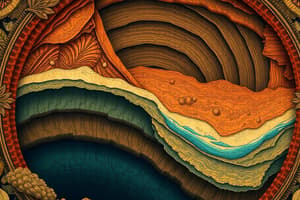Podcast
Questions and Answers
Which of the following characteristics primarily differentiate the Earth's inner core from its outer core?
Which of the following characteristics primarily differentiate the Earth's inner core from its outer core?
- The inner core consists mainly of silicon, while the outer core is composed of iron and nickel.
- The inner core is solid due to immense pressure, whereas the outer core is liquid due to slightly less pressure. (correct)
- The inner core is liquid, allowing for convection currents, while the outer core is solid and stable.
- The inner core is significantly cooler than the outer core, resulting in its solid state.
Considering the composition and physical properties of Earth's layers, how does the mantle differ from the crust and the core?
Considering the composition and physical properties of Earth's layers, how does the mantle differ from the crust and the core?
- The mantle and the core are both composed of metal while the crust is composed of magma.
- The mantle is primarily composed of solid iron, unlike the crust which is rocky and the core which is liquid.
- The mantle consists of gaseous elements, setting it apart from the solid crust and the metallic core.
- The mantle is a semi-solid magma layer, while the crust is solid rock and the core is composed of metal. (correct)
Why is it conceptually challenging to define the exact number of layers that constitute the Earth?
Why is it conceptually challenging to define the exact number of layers that constitute the Earth?
- Because the boundaries between the core, mantle, and crust are not clearly defined.
- Because each of the three main rocky layers has sublayers, and the Earth also has atmospheric layers. (correct)
- Because the Earth's atmosphere is constantly changing, adding new layers over time.
- Because the Earth's rocky portion is uniform, lacking distinct layers beyond the crust.
If a new planet were discovered with a similar layered structure to Earth, which of the following characteristics would be most likely observed?
If a new planet were discovered with a similar layered structure to Earth, which of the following characteristics would be most likely observed?
Considering the relative positions of Earth's layers, which sequence accurately describes the order from the surface to the center?
Considering the relative positions of Earth's layers, which sequence accurately describes the order from the surface to the center?
Flashcards
Crust
Crust
The outermost rocky layer of Earth, where life exists.
Mantle
Mantle
A semi-solid layer of magma made of iron, magnesium, and silicon, located between the crust and core.
Core
Core
The central layer of the Earth consisting of a solid inner core and a liquid outer core, both primarily made of metal.
Inner Core
Inner Core
Signup and view all the flashcards
Outer Core
Outer Core
Signup and view all the flashcards
Study Notes
- There are three main rocky layers of the Earth: the crust, the mantle, and the core.
- Layering is a common feature in many other planetary bodies as well.
Core
- Consists of a solid metal inner core and a liquid metal outer core.
- It begins 1,800 miles below the surface and continues over 2,000 miles to the Earth's center.
- Both the inner and outer core are defined as a single layer due to their metal makeup, similarities, and basic differences from the mantle and crust.
Inner Core
- Composed of extremely hot (over 9,000 degrees F) metal, mainly iron and nickel.
- Experiences incredible pressure, as much as 3.6 million atmospheres.
- The extreme pressure keeps the inner core solid despite the high temperature.
- Some scientists consider the inner core as a metallic plasma acting as a solid due to the combination of heat and pressure.
Outer Core
- It is liquid due to slightly less pressure than the inner core.
- Approximately 2,000 miles thick and composed of iron and nickel.
- Movement within the outer core generates Earth's magnetic field, creating the North and South Poles.
Mantle
- Makes up about 84% of Earth's total volume.
- Extends approximately 1,800 miles towards the Earth's core, starting about 20 miles below the surface.
- Considered semi-solid, with flowing molten iron, magnesium, and silicon comprising its layer.
- The mantle is made up of the asthenosphere, central mantle, and lower mantle.
Asthenosphere
- Uppermost layer of the mantle proper, starting approximately 60 miles below the Earth's surface.
- Extends down about 400 miles.
- This layer moves like a convection oven as hot molten magma pushes towards the Earth's crust, sometimes causing volcanos or earthquakes.
Central Mantle
- Also known as the transition zone.
- Extends from 250 miles to 410 miles below the Earth's surface.
- Rocks transition from their surface structures to a much denser form in this layer.
- This increase in density may prohibit slabs of the lithosphere from falling completely through the mantle.
- The central mantle holds as much water, in the form of hydroxide, as can be found in all the Earth's oceans.
Lower Mantle
- Begins slightly more than 400 miles below the surface of the Earth.
- It is the hottest and densest layer of the mantle.
- More solid than other mantle layers due to increased pressure.
- The true structure of the lower mantle is often debated by scientists.
Crust
- The livable rocky surface of the Earth that supports all life.
- Thinnest layer, averaging about 20 miles thick.
- Thinnest at the bottom of the ocean (approximately 3 miles thick) and thickest under mountains.
- It is solid and brittle, made of rocks, minerals, and metals.
Lithosphere
- Made from the lower portion of the crust and the uppermost part of the mantle.
- It is in constant motion, with the outer crust being pushed down into the mantle to be melted, cooled, and reintroduced.
Tectonic Plates
- The crust is made of multiple tectonic plates, which are pieces of the Earth's lithosphere separated from other large chunks.
- Tectonic plates average around 60 miles thick and include both oceanic and continental crust.
- The nine major tectonic plates account for the continents of the world.
- Convection currents in the mantle slowly push and pull the plates, leading to geological activity.
- Fault lines between tectonic plates are prone to earthquakes and volcanic activity.
- Seismologists study the movement of the crust known as earthquakes and measure their magnitude.
Scientific Principle
- Gravity is the primary factor that causes the different layers of the Earth.
- Density increases from the outer layers to the central layers due to gravity pulling the densest materials toward the center.
- Incompatible elements were pushed outward as the core formed.
Studying That Suits You
Use AI to generate personalized quizzes and flashcards to suit your learning preferences.




